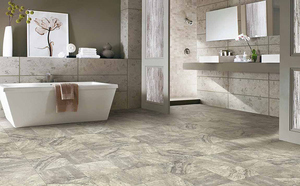Body
Tiles are a durable, stylish choice for both walls and floors, commonly found in kitchens, bathrooms, hallways, and outdoor spaces. But to keep them looking their best, tiles require regular care tailored to the material and setting. Whether you’ve installed classic ceramic tiles, natural stone, or modern textured finishes, adopting a proper cleaning routine helps preserve their finish and extend their lifespan.
This guide outlines practical cleaning and care tips for different tile types and offers insight into maintaining grout, dealing with stains, and knowing when deeper intervention is needed.
1. Understanding Your Tile Type
The first step in proper tile maintenance is knowing what you’re working with. Different tile materials respond to cleaning methods and products in very different ways:
- Ceramic tiles: Glazed ceramic is one of the easiest to clean and maintain, ideal for walls and low-traffic floors.
- Porcelain tiles: Denser and more durable than ceramic, often used for high-traffic areas and wet zones.
- Natural stone tiles: Includes limestone, slate, travertine, and marble—these require more delicate care and sealing.
- Mosaic tiles: Often used in feature areas like splashbacks or shower niches, with lots of grout lines to manage.
Each tile type has its own needs, so always check care instructions specific to the material, especially for natural stone.
2. Daily & Weekly Cleaning Routines
For Floor Tiles:
- Sweep or vacuum regularly to prevent dirt and grit from scratching the surface.
- Mop with warm water and a mild, pH-neutral cleaner once or twice a week.
- Avoid oil-based cleaners or anything too acidic, especially for natural materials.
For Wall Tiles:
- Wipe down with a soft cloth or sponge using mild detergent.
- In kitchens, degrease regularly around cooking areas to prevent build-up.
- In bathrooms, squeegee down shower tiles to prevent soap scum and water stains.
Using a microfibre cloth helps avoid scratching while lifting residue efficiently.
3. Grout Maintenance Matters
Grout is often the first area to show signs of wear and discoloration. Because it’s porous, it can absorb moisture, dirt, and stains if left untreated.
Tips for keeping grout clean:
- Use a soft-bristled brush and baking soda paste for gentle scrubbing.
- Avoid bleach unless necessary—it can degrade grout over time.
- Apply a grout sealer annually (especially in wet areas) to prevent absorption of dirt or mildew.
- Ventilate bathrooms well to reduce humidity and moisture buildup on grout lines.
If your grout is too far gone, consider regrouting or using a grout pen to refresh the colour.
4. Stain Removal Tips by Material
Ceramic & Porcelain Tiles:
- Most stains can be lifted with warm water and gentle soap.
- For tougher marks (e.g., wine or coffee), a mix of vinegar and baking soda can help, though be cautious of using vinegar on stone-effect finishes.
Natural Stone Tiles:
- Avoid acidic cleaners entirely—these can etch the surface.
- Use a stone-safe pH-neutral cleaner, and blot spills immediately.
- Oil stains may require a poultice paste made of baking soda and water.
Because stone is porous, regular sealing is recommended to protect against stains and moisture intrusion.
5. Dealing with Soap Scum & Hard Water
Soap scum and mineral deposits are common in bathrooms, especially in hard water areas.
To manage this:
- Use a vinegar and water solution for regular maintenance on glazed tiles (avoid this on natural stone).
- Consider installing a water softener if buildup is frequent.
- Rinse and dry tiles after showers to reduce long-term marks.
Shower screens, trims, and adjacent tile edges also benefit from regular wiping down to prevent mould or discoloration.
6. Seasonal & Deep Cleaning
Every few months, a deeper clean can help rejuvenate tile surfaces, especially in high-use areas like entryways and kitchens.
- Use a steam mop on porcelain tiles for a deeper clean (if approved by the manufacturer).
- Lift rugs and clean beneath to avoid damp or dust buildup.
- Outdoors, hose down patio or external tiles, removing moss or algae as needed.
Always test a small hidden area before using any new cleaning product or method.
7. Preventative Care Tips
Proper tile maintenance isn’t just about cleaning—small preventative actions make a big difference:
- Use doormats at entrances to limit dirt tracking.
- Add rugs or mats in high-wear areas like under kitchen sinks.
- Place furniture pads beneath chairs and tables to avoid scratching.
- Reseal grout and natural stone surfaces every 1–2 years.
A few simple habits can prevent costly repairs and keep tiles looking fresh over the long term.
8. When to Repair or Replace
Despite best efforts, damage can occur—especially in high-traffic zones. Here’s when to consider repairs:
- Loose tiles may indicate underlying adhesive issues or moisture damage.
- Cracked tiles can often be individually replaced if you have spares.
- Deep grout deterioration may require full regrouting.
- Persistent stains that resist cleaning may call for tile resurfacing or replacement.
It’s always a good idea to keep a few spare tiles from your original installation in case replacements are needed in the future.
Conclusion
Maintaining tile doesn’t have to be a chore. With the right routine and attention to materials, it’s easy to keep both floors and walls looking their best for years. Simple daily care, seasonal deep cleaning, and occasional sealing can prevent most common issues.
Whether you're caring for a freshly renovated space or giving a long-standing surface a refresh, understanding your tile type and adopting a consistent approach can go a long way.








Comments